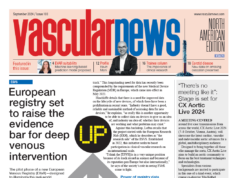
Treating abdominal aortic aneurysm patients in an outpatient setting is feasible, with 0% mortality in a series conducted in Switzerland, according to data presented at the Controversies & Updates in Vascular Surgery symposium (17–19 January 2013) in Paris, France. Mario Lachat, University Hospital Zurich, Switzerland, told delegates that this type of procedure saves hospital costs and can be used in up to 40% of EVAR patients.
“Ambulatory surgery, also called same day home, day surgery, outpatient surgery, or surgery in outclinic patient, has shown significant clinical and economical advantages, but there is few information on these for EVAR or TEVAR cases,” Lachat said.
The first experience with EVAR in outpatients was reported by Jacques Bleyn, Antwerp Blood-vessel Center, Belgium, at the CX Symposium in 2003. In that experience, 23 patients treated underwent percutaneous EVAR with local anaesthesia between 1998 and 2002. All patients were discharged, with no deaths in the group. “Bleyn told me he had to stop this programme because of reimbursement issues,” Lachat stated.
Last year, Lachat added, a paper (Selection, 30-day outcome and costs for short stay endovascular aortic aneurysm repair, SEVAR) was published in the European Journal of Vascular and Endovascular Surgery by N Al-Zuhir et al. Out of 100 patients, the authors selected 33 patients to undergo short stay EVAR. They had a turndown rate of 19%, mainly due to logistics, challenging procedure and urologic complications.
Lachat noted that, accompanying the paper there was a commentary by HH Dosluoglu and ML Dryjski, which said: “There is a strong trend in the USA to discharge patients on the first postoperative day. […] Nevertheless, the majority of uncomplicated percutaneous EVAR patients, particularly those who undergo procedure under local anaesthesia, do remarkably well and can be safely discharged home the same day.” The problem, Lachat stated, is that only 6% of patients in the USA undergo EVAR under local anaesthesia. He added there are no data on this topic, and Jacques Bleyn did not publish the results of his series in a journal.
“So we decided to start outpatient EVAR at the University Hospital Zurich because we had good EVAR experience over 15 years (>1,000 patients) with local anaesthesia, and two years with percutaneous access. We identified that most of the relevant complications happened during or immediately after EVAR, less than three hours after the procedure, and started our series in 2011,” Lachat explained.
The inclusion criteria were straightforward anatomy for EVAR, transfer time to hospital for eventual re-admission shorter than 60 minutes, adult observer assistance for the first 24 hours, informed consent and technically successful procedure. Patients who had any serious intra-operative complication, procedural time over four hours or incomplete sealing of access vessels were excluded.
All the outpatient procedures were performed with local anaesthesia, femoral cutdown and percutaneous access with Proglide and the procedures were performed with urinary condoms instead of catheters. Lachat added that the EVAR procedures are being performed in a hybrid operating room, with reduced amount of contrast. Also, in contrast with an inpatient setting, patients are taken to a recovery room after the procedure.
In order to compare outcomes of outpatient and inpatient procedures, Lachat and colleagues decided create a cohort of outpatients including patients from Zurich (29) and the cohort treated by Bleyn in Antwerp (23) (n=52 patients). These were compared to 52 EVAR in-patients. The results, Lachat said, showed that in-patient cases were clearly more complex, with one conversion and one case of bleeding, but overall there were no significant difference in outcomes between the two groups. Lachat commented that, so far, 100 cases have been treated, and still there was no difference in outcomes.
The group also performed a cost-benefit analysis, comparing 21 outpatients with 21 in-patients treated with a simple modular stent graft, with main body and contralateral limb module. “In our hospital, there was a benefit for outpatients in terms of ward/care costs, medical-technical costs, administration costs and total costs,” Lachat said.
Summarising his findings, Lachat told delegates that ambulatory EVAR is feasible in up to 40% of abdominal aortic aneurysm patients, with 0% mortality in 100 cases, and is reproducible, with two centres assessed at two different periods of time. The major advantages, he continued, are that there were no nosocomial or wound infections, no delirium, excellent patient acceptance (97%) and significant cost reduction.
“The feasibility, reproducibility and safety of ambulatory EVAR have been proven in selected patients, percutaneously, with local anaesthesia and with safety rules for the patient. There are major clinical and economic advantages, but probably a randomised controlled trial would be useful,” he said. “Patients fulfilling outpatient criteria should be treated or at least considered as outpatients and medical care should be minimised to allow spontaneous recovery.”
Finally, Lachat stated that in approximately 40% of the EVAR cases, there is no need for routine use of general anaesthesia, intensive care, intermediate care or bed rest. In addition, there is no need for routine urinary catheter and no need for basic analgesia, often nephrotoxic.”













